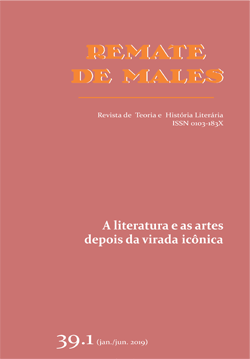Abstract
The article aims to present a way of interpreting the central character of the Odyssey through a theory of reception based on the co-creator role of the recipient. It is divided into four parts: after the presentation of the problem, the second part examines the key steps of the poem (especially of chants 9, 11 and 19) that support the argument of the third, in which are discussed possible meanings of absences or negations enformed by Odysseus. The final section argues for the possibility of reading the Odyssey as a mode of fiction that is neither mask nor duplicity, but as a radical alterity in relation to the real.
References
ADORNO, Theodor. Gesammelte schriften. Berlin: Directmedia, 2003.
BATSTONE, William. Provocation: the point of reception theory. In: MARTINDALE, Charles; THOMAS, Richard (eds.). Classics and the uses of reception. Malden/Oxford/Victoria: Blackwell, 2006, pp. 14-20.
BRANDÃO, Jacyntho Lins. Antiga musa: (arqueologia da ficção). Belo Horizonte: UFMG, 2005.
EAGLETON, Terry. After theory. New York: Basic Books, 2003.
EAGLETON, Terry. The event of literature. New Haven/London: Yale University Press, 2012.
HARTOG, François. Memoria di Ulisse. Racconti sulla frontiera nell’antica Grecia. Trad. A. T. Perazzoli. Torino: Einaudi, 2002.
HOMERI. Odyssea. Ed. P. von der Mühll. Basel: Helbing & Lichtenhahn, 1962.
HOMERO. Odisseia. Trad. e intr. C. Werner. São Paulo: Cosac Naify, 2014.
JAY, Martin. Historical explanation and the event: reflections on the limits of contextualization. New Literary History, Baltimore, n. 42, 2011, pp. 557-571.
JAY, Martin. Intention and irony: the missed encounter between Hayden White and Quentin Skinner. H&T, Middletown, n. 52, 2013, pp. 32-48.
LOPES, Rodolfo. Usos e sentidos de mythos e logos antes de Platão. Prometeus, São Cristóvão, n. 18, 2015, pp. 61-77.
MALTA, André. Homero múltiplo. Ensaios sobre a épica grega. São Paulo: EDUSP, 2012.
MALTA, A. A astúcia de ninguém: ser e não ser na Odisseia. Belo Horizonte: Impressões de Minas, 2018.
MARTINDALE, Charles. Introduction: thinking through reception. In: MARTINDALE, Charles; THOMAS, Richard. (eds.). Classics and the uses of reception. Malden/Oxford/Victoria: Blackwell, 2006, pp. 1-13.
ROMANO, Claude. Compréhension d’un texte et intention d’auteur. In: OUELBANI, Michel (Org.). L’intention. Tunis: Université de la Sorbonne Paris IV/Presses de l’Université de Tunis, 2010, pp. 57-84.
ROSS, W. D. (ed.). Aristotle’s metaphysics. Oxford: Clarendon Press: 1924 (reimp. 1970).
SARTRE, Jean Paul. Qu’est-ce que la littérature? Paris: Gallimard, 1948.
WERNER, Christian. Manobras poéticas entre a Ilíada e a Odisseia: o caso de Odisseu. Tese de doutorado em Letras Clássicas – Universidade de São Paulo, São Paulo, 2004.
WERNER, Christian. Nestor e a performance da tradição épica no canto 3 da Odisseia. PhaoS, Campinas, n. 12, 2012, pp. 101-127.
WERNER, Christian. Memórias da guerra de Troia: a tessitura épica da Odisseia de Homero. Coimbra: IUC, 2018.

O periódico Remate de Males utiliza a licença do Creative Commons (CC), preservando assim, a integridade dos artigos em ambiente de acesso aberto.


